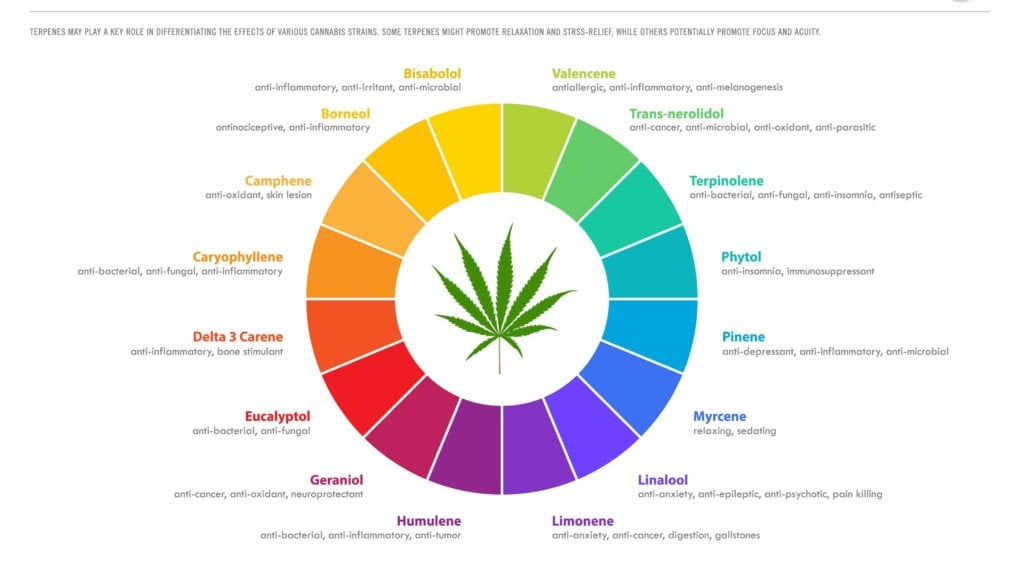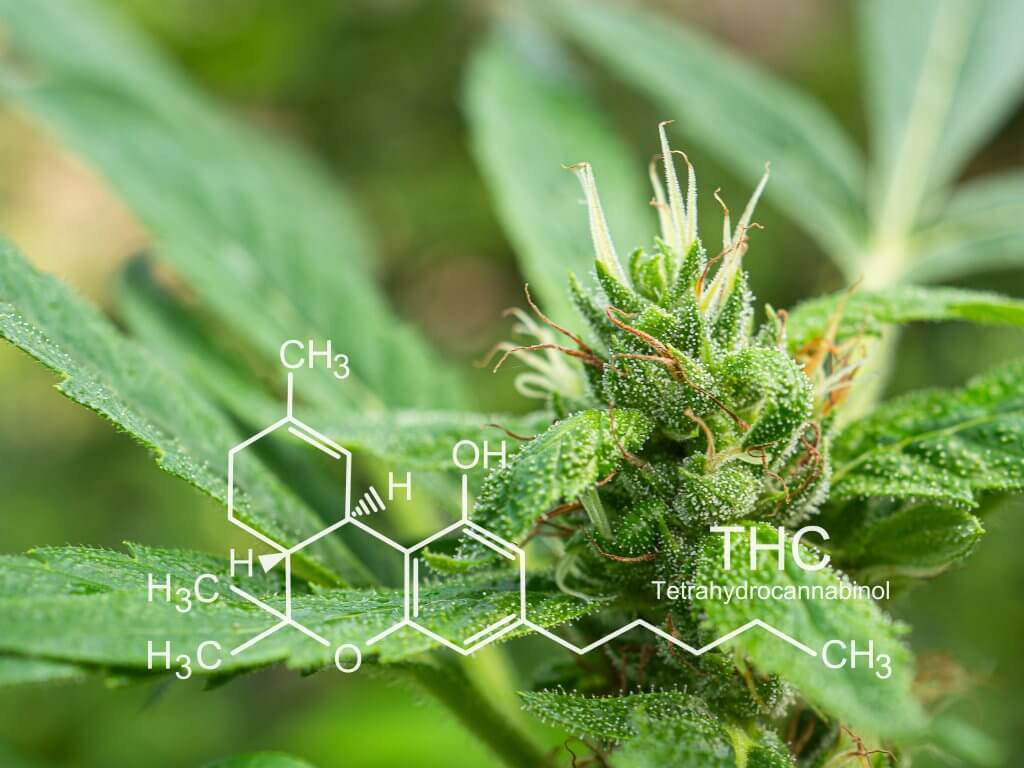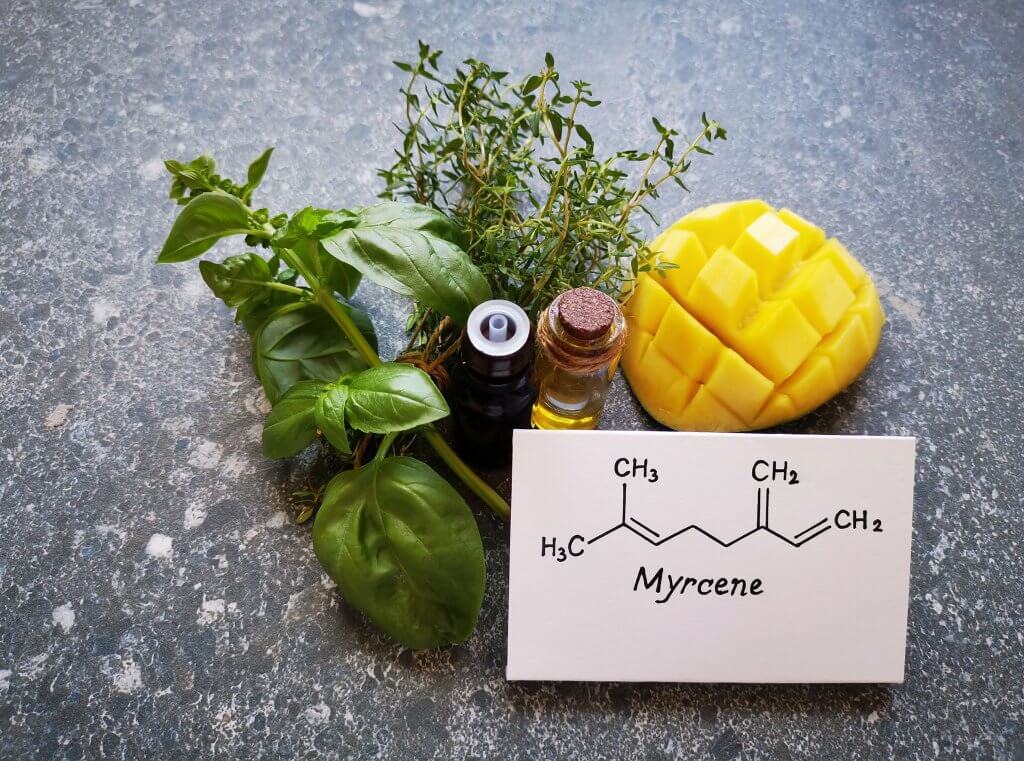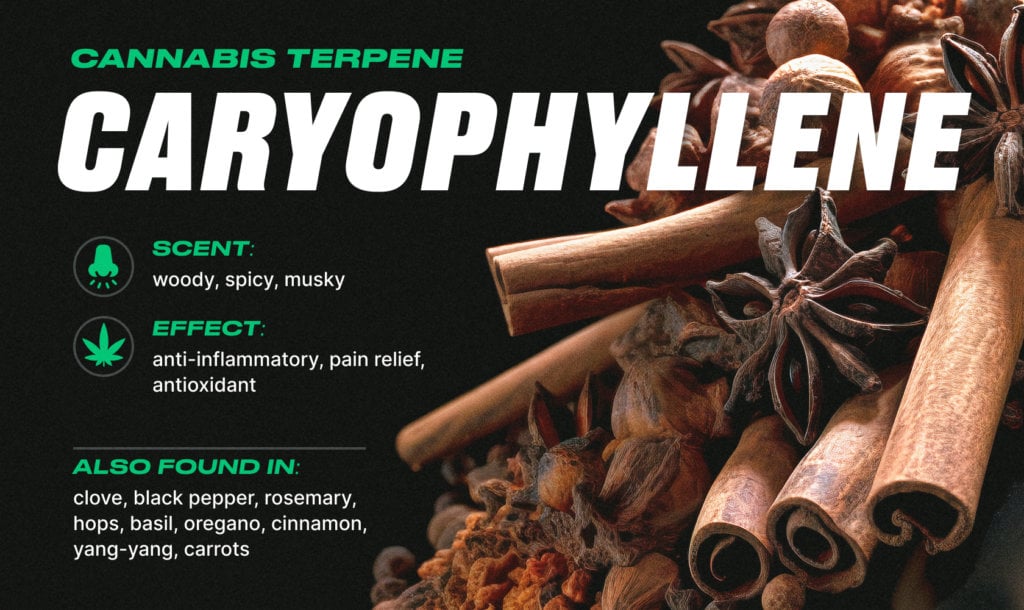Terpenes and Cannabinoids: What’s the Difference Between These Compounds?
Terpenes and cannabinoids are essential to your 420 experience, as they determine the sensations, aromas, and flavors you get. Most marijuana users know a thing or two about the latter, since THC and CBD are mainstream buzzwords.
Do you select weed strains based on cannabinoids alone? Perhaps it’s time to include terpenes in your criteria. Potent effects need refreshing tastes and scents for all-around enjoyment.
Are these two marijuana organic compounds any different? Terpenes emit distinctive aromas and flavors, while cannabinoids don’t. Their only similarity is that they both exist in marijuana trichomes.
Terpenes can influence the impact of cannabinoids in your body, but do they interact with the endocannabinoid system (ECS)? Why should you consider the terpene profile of a cannabis strain before buying?
Join me as I answer these and more questions about cannabinoids, terpenes, how they work, and the impact of their interplay.
Let’s get started.
What are terpenes?
Terpenes are sometimes called terps for short. They’re organic compounds found in most herbs, fruits, and plants, including hemp and pot. Terps benefit crops by attracting pollinators and acting as natural pest repellants.
An analysis of the cannabis plant anatomy shows it contains approximately 400 terpenes. These compounds occupy the resin glands or trichomes, the tiny hairs on leaves and buds.

Besides curbing infestations, terpenes ooze the refreshing aromas and flavors you enjoy in every puff. Some of the most abundant terpenes in cannabis plants include:
- Limonene: Produces a pleasant lemony, orange-like, citrus fragrance. Some enthusiasts say it’s an effective antioxidant. It may enhance cell protection in the body.
- Beta-caryophyllene: Delivers a sweet, peppery, slightly woody aroma and flavor. It’s highly sought after for its potential to reduce inflammation.
- Humulene: Oozes an earthy, woody, herbal, spicy scent and taste. Many users consider it for its reported pain relief and appetite suppression.
- Pinene: Boasts a refreshing forest-like, spicy, woody aroma and flavor. Some enthusiasts say it boosts the focus-enhancing capabilities of weed.
- Linalool: Releases a floral, spicy, slightly citrus odor and taste. Many consumers report it has sedative effects that calm their overactive nervous systems.
Do you want to maximize these dynamic flavors, aromas, and effects? Consider the highest terpene strains. These fragrant cultivars pack more concentrated levels of authentic marijuana tastes and scents. They offer a richer, fuller 420 experience.
Besides their unique aromatic appeal, cannabis terpenes could also be medicinal. They may suit various modern natural treatments thanks to their diverse chemical makeup.
What are cannabinoids?
Cannabinoids are chemical compounds that interact with your body’s endocannabinoid system (ECS). They usually target receptors such as CB1 and CB2 to produce various effects.
These compounds can originate from plants like marijuana (phytocannabinoids) or the human body (endocannabinoids).
Weed cannabinoids and terpenes occur in trichomes on female flowers. Studies show that most weed-derived cannabinoids are therapeutic. Their effects range from mood enhancement to discomfort relief.
Cannabis plants boast over 100 cannabinoids, with the prominent ones being:

- Tetrahydrocannabinol (THC): The most famous and well-studied cannabinoid. It causes marijuana’s sought-after psychoactive effects, popularly known as the “high.”
- Cannabidiol (CBD): A primary and abundant marijuana cannabinoid without the mind-altering effects of THC. Some believe it’s highly therapeutic. CBD is a potential modern treatment for PTSD, anxiety, depression, and insomnia.
- Cannabinol (CBN): This cannabinoid comes from tetrahydrocannabinolic acid (THCA) as marijuana ages or gets exposed to light, air, and heat. It’s mildly psychoactive with sedative effects.
- Cannabigerol (CBG): A minor cannabinoid derived from the cannabinoid cannabigerolic acid (CBGA). It’s famous for its mood-regulating capabilities. CBG isn’t psychoactive, and most weed strains contain only trace amounts.
How do terpenes work?
Terpenes play two essential roles after their secretion by cannabis resin glands:
- Emit distinctive flavors and aromas (ideal for aromatherapy)
- Interact with specific receptors in the body (to boost weed’s therapeutic effects)
Many cannabis connoisseurs say inhaling the scent of some terpenes could enhance emotional well-being. Linalool’s floral aroma produces a soothing effect that may favor sleep improvement. The refreshing citrus fragrance in limonene might elevate mood.
Some cannabis terpenes may also contain therapeutic properties ideal for various medical conditions. They bind to specific hormones and receptors, such as the adenosine and GABA receptors, impacting the body’s cellular metabolism.
Research shows the myrcene terpene is the most abundant monoterpene in weed. It boasts reported antioxidant, anti-inflammatory, and analgesic properties. Pinene is also a potential anxiolytic that may ease anxiety and stressful feelings.

Cannabinoids and terpenes: How do cannabinoids work?
The functional nuances of terpenes vs. cannabinoids are subtle. Both compounds could bind to cannabinoid receptors in your body. The latter works by stimulating two primary receptors in the ECS: CB1 and CB2.
The ECS consists of a complex organ network that supports various body functions, including:
- Memory
- Movement
- Pain
- Appetite
- Immunity
- Metabolism
CB1 receptors exist in your central nervous system, and CB2 receptors occur in your peripheral immune system.
Marijuana cannabinoids have distinctive psychotropic properties. As they bind to the receptors, they trigger a chain of biochemical reactions. This interaction can result in mind alteration, increased appetite, euphoria, and sometimes analgesia.
These cannabinoid effects can vary depending on the receptor activated and its location in the body. CB1 activation usually triggers psychoactive sensations. Stimulating CB2 receptors could modulate your immune system to produce anti-inflammatory effects.
Terpenes vs cannabinoids: What gets you high?
Although cannabis terpenes and THC could cause subjective experiences like mood upliftment, THC is usually responsible for getting you high. Terpenes may influence the effects of THC, but they can’t be psychoactive by themselves.
THC contains mind-altering properties. It stimulates sections in your brain responsible for responding to pleasure. This reaction releases dopamine, a chemical that produces the euphoric, relaxed sensations you experience from weed consumption.
Tetrahydrocannabinol may enter your bloodstream faster through smoking or vaping pot. This consumption method brings the high quicker than oral intake. The effects typically get the best of you in 30 minutes and last up to three hours.
Your body usually takes longer to absorb THC from edibles. Oral ingestion may cause longer-lasting sensations due to this delay.

The interplay of cannabinoids and terpenes
THC and terpenes are typically more abundant in marijuana trichomes than in sugar leaves.
Although these compounds have distinct attributes and functions, they can join forces to determine the overall marijuana effects. By working together, they offer clues about what to expect from a specific marijuana strain.
Terps and cannabinoids interact in a phenomenon called the “entourage effect.” Different cannabis compounds work harmoniously through this process. They end up producing fuller, better effects than when consumed individually.
In other words, terps and cannabinoids can converge within the ECS to enhance each other’s effects and therapeutic properties.
Some studies observe that terpenes can increase cannabinoid activity by triggering specific receptors. These aromatic compounds could promote the mood-stabilizing effects delivered by THC and CBD.
Which terpene is also a cannabinoid?
The beta-caryophyllene terpene doubles as a cannabinoid. It’s among the most abundant terps in weed plants, black pepper, hops, rosemary, cloves, and copaiba.
Scientists consider beta-caryophyllene a cannabinoid since it interacts with the ECS by binding directly to the CB2 receptors. This interplay produces spicy aromas and flavors while contributing to marijuana’s physiological effects.
As both a cannabinoid and an aromatic compound, caryophyllene boasts significant therapeutic potential. Some studies claim this terpene contains anti-inflammatory, analgesic, antioxidant, neuroprotective, anxiolytic, and anticancer properties, ideal for pain, anxiety, and stress relief.

Bring the entourage effect closer home
Many people get confused trying to distinguish between terpenes and cannabinoids. Although both compounds are abundant in marijuana plants and often collaborate to deliver enhanced, more potent effects, they’re unrelated.
Cannabinoids are present in most plant species, but the human body also produces its own. These compounds interact with receptors within the ECS, spurring various effects into action.
Terpenes occur naturally in almost all plants, enhancing the aromas and flavors. They don’t all bind directly to receptors like cannabinoids, but they could be therapeutic.
Research is underway on the interplay of terps and cannabinoids. Scientists seek to establish how this relationship affects the scope of weed’s psychoactive and medicinal benefits. Early evidence shows terpenes could enhance the effects of cannabinoids.
Ready to put this knowledge into practice? Explore our high THC seeds for a selection of resilient cannabis strains with potent effects, aromatic buds, and flavorful puffs.